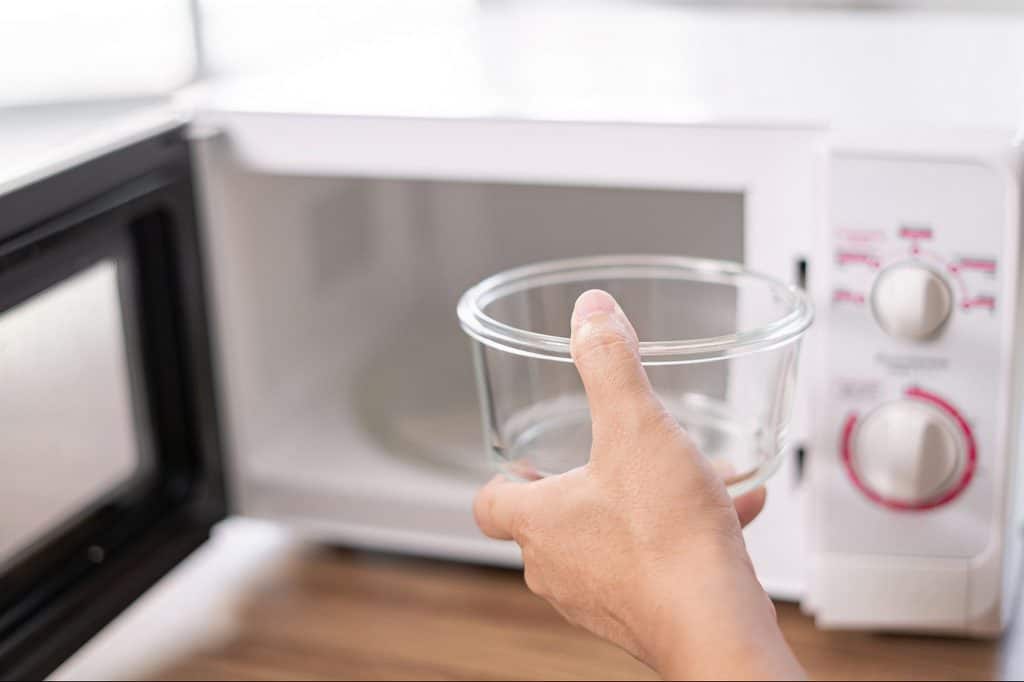Can You Put a Glass Mug in the Microwave? How to Tell If It’s Safe

When you’re in a hurry and need to heat up your coffee or tea quickly, it’s tempting to just pop your mug in the microwave. But what if your mug is made of glass? Can you put it in the microwave? And if so, how can you tell if it’s safe to do so?
The short answer is that it depends on the type of glass your mug is made of. Some types of glass are microwave-safe, while others are not. Additionally, even if your glass mug is microwave-safe, you still need to take precautions to ensure that it doesn’t get too hot and potentially break or cause harm.
Types of Glass
There are many different types of glass, and they all have different properties that affect their ability to be used in the microwave. Here are some of the most common types of glass:
- Tempered Glass: Tempered glass is a type of glass that is heated and then rapidly cooled to make it stronger and more durable. Tempered glass is microwave-safe, as long as it doesn’t have any metallic decorations or coatings.
- Borosilicate Glass: Borosilicate glass is a type of glass that is made with boron and silica. It is known for being very resistant to thermal shock, which makes it a popular choice for cookware and laboratory glassware. Borosilicate glass is microwave-safe.
- Soda-Lime Glass: Soda-lime glass is the most common type of glass used in household items, including glass mugs. It is made with silica, soda, and lime, and is not as resistant to thermal shock as tempered or borosilicate glass. Soda-lime glass may be microwave-safe, but it’s important to check with the manufacturer before putting it in the microwave.
How to Tell If Your Glass Mug Is Microwave-Safe
If you’re not sure whether your glass mug is microwave-safe, there are a few things you can do to find out:
- Look for a “microwave-safe” label: Many manufacturers will label their products as microwave-safe if they are safe to use in the microwave. Look for a label on the bottom of your glass mug or on the packaging it came in.
- Check the manufacturer’s instructions: If your mug didn’t come with a “microwave-safe” label, check the manufacturer’s instructions to see if they mention whether or not it’s safe to use in the microwave.
- Do the “Hot Water Test”: Fill your glass mug with hot water and microwave it for one minute. Carefully touch the outside of the mug. If it’s cool to the touch, it’s likely microwave-safe. If it’s hot or warm, it may not be safe to use in the microwave.
Can You Microwave Glass Pyrex?
Pyrex is a popular brand of glass cookware known for its durability and versatility. Many people wonder if Pyrex glass containers can be safely used in the microwave, and the answer is yes, but with some important considerations.
First, it’s important to ensure that your Pyrex glass container is microwave-safe. Most Pyrex glass containers are marked as microwave-safe, but it’s always a good idea to double-check the label or manufacturer’s instructions to be sure. If you use a container that isn’t safe for the microwave, the glass could crack, break, or even explode in the microwave, which could be dangerous.
It’s also important to follow proper microwave heating guidelines when using Pyrex glass containers. Avoid placing a cold Pyrex glass container directly into a hot microwave, as the sudden temperature change can cause the glass to shatter. Instead, allow the container to come to room temperature before microwaving it.
Another important tip is to avoid microwaving Pyrex glass containers that are heavily scratched, chipped, or cracked. Damaged glass containers can weaken over time and may be more likely to break or shatter during microwave use.
When microwaving food or beverages in a Pyrex glass container, it’s also a good idea to cover the container with a microwave-safe lid or paper towel to prevent splatters and spills. This can also help to distribute the heat more evenly, preventing some areas from becoming too hot while others remain cool.
Overall, Pyrex glass containers can be safely used in the microwave as long as they are marked as microwave-safe and are not heavily damaged. By following the correct instructions for heating in the microwave and taking steps to avoid sudden temperature changes, you can safely and effectively use Pyrex glass containers to heat up your favorite foods and drinks.
Precautions to Take When Using a Glass Mug in the Microwave
Even if your glass mug is microwave-safe, there are still precautions you should take to ensure that it doesn’t get too hot and potentially break or cause harm. Here are some tips:
- Use a microwave-safe plate: Place your glass mug on a microwave-safe plate or tray to catch any spills or splatters.
- Don’t overheat: Only microwave your glass mug for the amount of time recommended by the manufacturer or recipe. Overheating can cause the glass to get too hot and potentially break.
- Stir your drink: If you’re heating up a liquid in your glass mug, like coffee or tea, be sure to stir it well after microwaving to distribute the heat evenly.
- Use a towel or oven mitts: Use a towel or oven mitts to remove your glass mug from the microwave, as it may be hot to the touch.
- Let it cool: After removing your glass mug from the microwave, let it cool for a few moments before using or touching it.
- Inspect for damage: Regularly inspect your glass mug for any signs of damage, such as chips or cracks. If you notice any damage, do not use it in the microwave.
- Avoid sudden temperature changes: Do not put your glass mug directly from the freezer or refrigerator into the microwave, as the sudden temperature change can cause it to break.
Can a Cracked or Chipped Glass Mug Be Used in the Microwave?
Glass mugs can be prone to chipping or cracking over time due to wear and tear, accidental drops, or temperature changes. If you have a glass mug that is chipped or cracked, you may be wondering whether it’s safe to use it in the microwave. The short answer is no; you should not use a damaged glass mug in the microwave.
When a glass mug is broken or cracked, it is less strong and more likely to break or shatter when heated. This is because the heat can cause the mug to expand or contract, putting pressure on the weakened areas and potentially causing them to break.
Additionally, the jagged edges of a chipped or cracked glass mug can pose a risk of injury if they break off during heating or while handling the mug.
Using a damaged glass mug in the microwave can also lead to uneven heating, as the cracks or chips can cause the heat to be distributed unevenly. This can result in some areas of the beverage being too hot, while others remain lukewarm or cool.
Uneven heating can also increase the risk of overheating, which can cause the beverage to boil over or scorch, potentially damaging the mug and the microwave.
It’s important to note that even if the damage to your glass mug appears to be minor, such as a small chip or hairline crack, it’s still not safe to use it in the microwave. It’s best to err on the side of caution and choose a different microwave-safe container.
WARNING
If you’re unsure whether your glass mug is safe to use in the microwave, inspect it carefully for any signs of damage before using it. Look for any chips, cracks, or other damage that could compromise the integrity of the mug. If you notice any damage, no matter how small, it’s best to discard the mug and choose a new one.
Alternative Microwave-Safe Materials
If you’re not comfortable using a glass mug in the microwave, there are other materials you can use that are microwave-safe. Here are some options:
- Ceramic: Ceramic mugs are a popular alternative to glass mugs for microwave use. Look for mugs that are labeled as microwave-safe.
- Plastic: Some plastic mugs are microwave-safe, but it’s important to check the label or packaging to ensure that they are.
- Silicone: Silicone mugs are another option that are microwave-safe. They are also lightweight and easy to clean.
- Paper or Cardboard: Disposable paper or cardboard cups can be used for microwave heating, but make sure to remove any plastic lids or coatings first.
Conclusion
In conclusion, whether or not you can put a glass mug in the microwave depends on the type of glass it’s made of. Tempered and borosilicate glass are microwave-safe, while soda-lime glass may or may not be safe, depending on the manufacturer’s instructions. If you’re not sure whether your glass mug is microwave-safe, look for a label or do the “Hot Water Test.”
When using a glass mug in the microwave, be sure to take precautions to avoid overheating or potential breakage, and consider alternative microwave-safe materials if you’re not comfortable using a glass mug.






